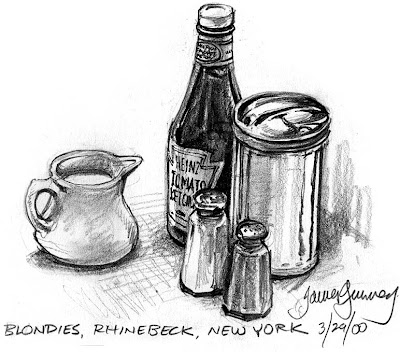 How you answer these questions lays at the heart of how you approach a drawing.
How you answer these questions lays at the heart of how you approach a drawing.The first drawing interprets the classic diner still life as separate, rational objects bounded by clear outlines. The salt and pepper shakers appear as distinct shapes that could be cut out from the background.
 The second drawing is a bit more subjective. The pepper shaker on the right melts into the background a little more, and tones of shadows blend the bases of the objects into the table surface.
The second drawing is a bit more subjective. The pepper shaker on the right melts into the background a little more, and tones of shadows blend the bases of the objects into the table surface.The third drawing, made with a brush and watercolor, interprets the world not as a series of definite objects but rather as spots or shapes that come together to suggest forms. The creamer at the lower left almost disappears into its surroundings; we see only a hint of its handle.
 This is not merely a matter of style or technique. One approach is not better than another. There’s no right or wrong way to see the world and no right or wrong way to draw it. Different people actually see things differently.
This is not merely a matter of style or technique. One approach is not better than another. There’s no right or wrong way to see the world and no right or wrong way to draw it. Different people actually see things differently.In fact, new research in visual perception suggests that the human retina is not like a camera, but more like a kind of a pre-brain. Some groups of retinal receptors bundle visual information into packets describing linear boundaries. Other receptors bundle information about tonal shapes. These packets are then processed downstream in the visual cortex. The retina transmits data at a rate of 10 million bits per second, which is about equivalent to an Ethernet connection. (link)
The way you see is probably not the way I see, regardless of our training or tradition. The way your retina apportions its visual processing tasks is as unique as your fingerprint. You may see things more in terms of line and I may see things more in terms of tone.
The way our eyes apprehend the world is infinitely mysterious. As artists we need to yank ourselves out of our comfortable habits of perception. We need to grow beyond the easy tricks that worked for us in the past. We need to strive always to see with new eyes.
Không có nhận xét nào:
Đăng nhận xét